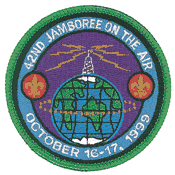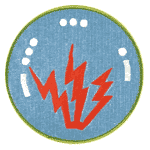![]() September 1999
September 1999
By Kathy Vilim DaGroomes

Amateur radio operators, or "hams," have a contagious enthusiasm for their hobby. John Cross, unit commissioner and assistant Scoutmaster of Troop 870, Houston, Tex., discovered that six years ago when he was cleaning out patrol boxes at the church where his troop meets.
"The local radio club gives amateur license exams at the church on Saturdays, and I saw all these strange-looking guys show up with funny-looking license plates and lots of antennas on their cars," he remembers with a laugh. "I got to talking with them and found they were enthusiastic, interesting people doing something they thought was an awful lot of fun."
So catching was this enthusiasm that, only a month later, Cross passed the exam for his General Class amateur radio license. The license came with a ham call sign, KB5YBX; since then, John has upgraded his license level twice and is now AB5OX.
"What attracted me to the hobby is the fact that radio is interesting," John explains. "And all the people I met were really nice."
Over the next four years, the other Cross family members became hams: in 1993, wife (and troop committee chairman), Virginia (KC5CIZ), plus Eagle Scout son Richard (KC5CHW), 18; Eagle Scout Robert (KC5KIL), 15, in 1994; and in 1997, Star Scout David (KD5AOQ), 12.
Until recently, Virginia would regularly joke in her annual family Christmas letter about John's "latest expensive hobby." His previous passions have included soaring in gliders, piloting small aircraft, pistol and silhouette shooting, building and launching model rockets, and flying radio-controlled airplanes. Virginia eventually joined her husband in most of those hobbies.
But once the Crosses had children, it became evident that some of those activities weren't "family-friendly" (gliders, for example, don't have enough seats). And some required too much work (radio-controlled planes crash and have to be repaired) or time (when Hurricane Allen loomed, Virginia flew their airplane 200 miles out of town to house it safely while John had to transport the glider).
Although they didn't realize it at the time, as they dropped their earlier hobbies, John and Virginia were looking for something the whole family could take up. That something turned out to be ham radio.
But in the instant-access world of the Internet, why would anybody still be excited to pick up a static-laden voice or faint Morse code signal from parts unknown?
Call it the "magic of radio" - the hobby's mystique that is the source of much of its operators' contagious enthusiasm.
With neither telephone wires nor computer modems - just radio waves and air - a person can communicate with someone halfway around the world. And whom you contact depends on atmospheric conditions and which way the radio waves bounce. For the Cross kids, their parents, and countless other amateur radio enthusiasts, those aspects of ham radio are, to quote 10th grader Robert, "pretty cool."
About 200 of those enthusiasts, including the Cross family, are members of the Clear Lake Amateur Radio Club, or CLARC, one of the more than 3,000 amateur radio clubs nationwide.
Contacting a local radio club like CLARC is the easiest way to get started in ham radio, says John.
"Most local clubs have training programs and examinations, and the members will sit and talk with you for hours on end about the hobby," he says. "By making that contact, learning the fundamentals needed to get licensed, you receive a lot of information quickly. Plus, the contact with club members is generally very enthusiastic, which helps to build your interest."
Using portable hand-held radios, CLARC members regularly provide communication service and emergency coverage at several Houston-area fund-raising activities and other public events.
For example, the Crosses have worked the annual March of Dimes Walk America event for several years. In April 1998, about 35 CLARC members, including all the Crosses, provided ham radio support at Ellington Field - one of several Houston-area venues for the 30,000 participants in last year's Walk America.
John was one of two net controls (who coordinate all the volunteer amateur radio operators at the event), Virginia accompanied the ambulance, Robert assisted the ROTC volunteers, David provided communication at one of the rest stops, and Richard was assigned to help the Houston police department.
John, Virginia, Richard, Robert, and David can each describe unusual radio exchanges with hams from as far away as Cuba, Barbados, Canada, and Mauritius Island.
"A couple of years ago, I was practicing my Morse code early in the morning," John recalls. "I happened to talk to the same guy in Pennsylvania three days in a row and, on the third day, it was like we knew each other and I found out that all three times I talked with him, he was actually driving his car while sending and listening to Morse code. Very few people can do that."
An even more unusual experience occurred when CLARC members, including John and Virginia, visited some local elementary school students to teach them about ham radio. As part of NASA's SAREX (Shuttle Amateur Radio Experiment) program, several students, including Robert, were able to ask a question of ham radio operator and shuttle commander Ken Cameron (KB5AWP), who was orbiting in space.
Reasons for the Cross family's excitement about ham radio vary from Richard's interest in "playing with the electronics" to David's "talking to my friends on the radio" to John's "fun challenge of being able to converse with somebody in Morse code." But they all agree the hobby has brought them closer together.
"Ham radio has strengthened our family," says Virginia, "because we can all do things together. For instance, when we go to the CLARC potluck, we're all involved. Another way we're connected is just by being able to call when we're mobile - when we're in the car - to be sure everything's going all right. It's really fast and fun."
The family's ham radio activities include attending the CLARC monthly meeting, which often features a presentation about some technical aspect of their hobby. Or they may go to a related event, like the club's annual field day or banquet, or perhaps a CLARC-sponsored SKYWARN course, put on by the National Oceanographic and Atmospheric Administration to train club members to spot certain weather occurrences.
Virginia and the boys vary in the types of licenses they've received, but John has attained the highest-level one - the Amateur Extra. He puts his proficiency to use frequently.
For Scouting, John has taught the Radio merit badge at a Sam Houston Area Council camp and as a staff member at the Merit Badge Midway at the 1997 National Scout Jamboree.
Sometimes, he's one of two hams - one in the front car, one in the back -on a Scout camping trip. "Caravaning is not a good thing to do, so generally we'll drive between objectives," says John. "The guy in the last car can see if somebody had to pull over because of a problem and he can get the whole group to stop."
At home, John might be found on the upstairs radio set in the wee hours of the morning, increasing his number of contacts (known as QSOs) with faraway countries. Contacts are documented by an exchange of postcards called QSLs. He has already received the "Worked All States" Award, and once he contacts 100 countries (he currently has 65), he will add yet another certificate to the many recognitions family members have received for their various activities and achievements in ham radio.
On a more practical level, John or Virginia might use a car or hand-held unit to summon emergency assistance to an accident they've encountered on the way to work or put out a call questioning other hams about possible flooding or other adverse traffic conditions.
Using a signal-amplifying "repeater" and a phone "patch" - a radio link to the telephone system - owned by their club, each of the Crosses can make local calls free on his own hand-held unit - which, to the uninitiated, resembles a good-sized cell phone.
After the initial expenses for the hobby - the home and car units, the giant house antenna, and five color-coded hand-held radios - ham radio is "only as expensive as a person wants it to be," Virginia says. And frequent "hamfests" and "swapfests" allow hams to obtain quality used equipment.
In fact, the cost of the Crosses' ham radio hobby is low enough now that Virginia recently had to amend her Christmas letter.
John's most expensive hobby now? Collecting Scout patches.
Scouting magazine Associate Editor Kathy Vilim DaGroomes also wrote the Garfield Round-Up story in this issue.
Scouting and Amateur Radio
Amateur radio activity in the Scout program features the following three main elements:
|
The ARRL: Support for Hams
The American Radio Relay League (ARRL), founded in 1914, is the official voice of amateur radio in the United States, with more than 163,000 members. The league publishes more than 100 ham radio books and software products, two special-interest magazines, and a monthly journal. It provides a variety of services to members, including sending names of amateur radio instructors and clubs in a person's vicinity, details about study guides on getting licenses, and basic information on ham radio, the BSA Radio merit badge requirements, and membership in the ARRL itself. ARRL's field organization coordinates ham radio emergency communication services and monitors local government on zoning and other issues that affect the hobby. To contact the organization, write ARRL, 225 Main St., Newington, CT 06111-1494; call toll free, (800) 326-3942; fax (860) 594-0259; or e - mail newham@arrl.org and ask for free package "E2." |
| The Boy Scouts of America | http://www.scouting.org |